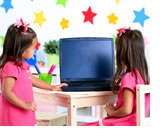
 Kids & Technology
Kids & TechnologyFinding the balance
Technology is in integral part of the world we live in and as such cannot be ignored by early childhood professionals.
There are significant numbers of applications for smart phones and tablet computers designed especially for preschool aged kids and many parents are willing to hand over their phones to kids.
In fact, ABC news in the USA recently reported on a study which showed that 75 per cent of mothers allow their children with smart phones and noted that some preschools and primary schools are purchasing tablets for kids to use in class.
This technology competes with other digital offerings including TV, handheld games and electronic toys.
The challenge is trying to figure out the best way to incorporate technology into child care services so it complements the other types of play based learning that children enjoy.
Editor of Children's Technology Review Warren Buckleitner PHD offers early childhood teachers many practical ideas on how to incorporate technology into the preschool environment and says technological experiences shouldn't be taught so much as integrated as part of the kid's daily routine. He says technology should also be used in balance with other non-digital activities and routines.
Warren Buckleitner's tips for Choosing and Using Technology for Preschoolers:
- Don't try to formally "teach" technology skills and competencies. Instead, set the stage for successful experimentation by providing the materials, introducing them, and offering support.
- Let children practice using technology by pretending with the types of gadgets they see their parents using, such as a non-working mouse or keyboard, cell phone, iPod or MP3 player.
- Use a wireless laptop so that you can bring a Web-based experience to children, in the context of their play.
- Have a large screen, either a projector or a large screen monitor that is easily seen by all children for story time, distance learning activities, or a digital photo slide show from a recent field trip to the zoo.
- Keep a camcorder and digital camera at the ready to capture and document children's work.
- Set the stage for social, active learning. Choose activities that involve more than one child, like playing a Web-based game, such as www.starfall.com, or drawing a picture at www.kerpoof.com.
- Encourage children to represent what they do using digital cameras.
- Introduce new technology during circle time, prior to placing it in a learning centre.
- Expand on your children's interests by letting them come up with search words and see the results in ways they can understand (e.g., as a set of images rather than text alone).
Technology Standards: What Kids Should be Able to Do:
- Use fine motor skills to use the mouse to move a cursor to a target on the screen.
- Show awareness of the "power keys" on a keyboard (e.g., "enter," "esc," "delete," and the space bar).
- Know the difference between the left and right mouse button (which can be helped by a small label or sticker).
- Be familiar with at least five quality interactive games or activities, in either screen- or toy-based formats.
- Have a basic working vocabulary of common technology terms, such as "digital camera," "computer," "Internet," "mouse," "keyboard," and "printer."
- Have been exposed to common technology terms in the natural context of everyday conversation, such as "on/off," "Internet," "browser," "software," "hardware," "computer," "mouse," "monitor," "keyboard," "digital camera," "printer," "battery," and so on.
- Have taken their first digital photo.
- Find the numerals on a QWERTY keyboard.
- Put a disk, cartridge, or DVD into a hardware device such as a computer.
- Type their first name on a QWERTY keyboard.
- Have been exposed to a variety of portable computing platforms such as V.Smile, Leapster, or the Tag Reading System; and be comfortable with concepts such as inserting new cartridges and turning devices on or off.
- Understand the basic functions of a browser, including how to open or close windows and use the "back" key.
NIEER researchers identify the last point as a particular concern to early childhood educators when planning classroom activities and say it dovetails with the question of whether children should engage in play with technology-based tools or be left to their own devices for creative play.
Although some technological tools do appear to be mimicking traditional childhood activities such as coloring, reading, and game-playing in general, they tend toward adult-scripted, rule-based activities versus child-directed, unstructured play. And the latter has been found to be incredibly influential in children's healthy development. Among the benefits of this kind of play are learning self-control and how to plan ahead, becoming problem-solvers, and working out emotional and social issues such as anxiety and sharing.
Much of the research on this topic suggests that the key for early childhood educators is to find a healthy balance between exposure to digital technology and conventional play based experiences. Many children have opportunities to use digital technology in the home and for some kids using a smart phone or tablet computer a normal part of daily life, therefore denying children access to this technology in the child care setting seems inappropriate and unrealistic.
Does technology have a place in the early childhood setting and how do kids access digital technology in your service? Tell us on CareforKids Social
© 2011 - All rights reserved
Care For Kids Internet Services Pty Ltd
ABN 55 104 145 735
PO Box 543 Balmain NSW 2041
privacy policy contact us